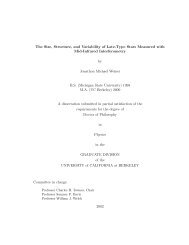Astro 160: The Physics of Stars
Astro 160: The Physics of Stars
Astro 160: The Physics of Stars
Create successful ePaper yourself
Turn your PDF publications into a flip-book with our unique Google optimized e-Paper software.
Problem set 3Problem # 1(a). Show that heat transfer by radiative diffusion implies a non-zero gradient for the radiation pressurewhich is proportional to the radient heat flux. Bearing in mind that the magnitude <strong>of</strong> the force per unitvolume in a fluid due to the pressure is equal to the pressure gradient, find the radient heat flux densitywhich can, by itself, support the atmosphere <strong>of</strong> a star with surface gravity g. Hence show that a star <strong>of</strong>mass M has a maximum luminosity given byL max = 4πcGMκwhere κ is the opacity near the surface. Obtain a numerical estimate for this luminosity by assumingthat the surface is hot enough for the opacity to be dominated by electron scattering. (This maximumluminosity is called the Eddington luminosity.To show that the heat transfer by radiative defusion implies a non-zero gradient we must begin withF r = − 4 aT 33 κρ ∇TF r ∝ P radknowing these relationships we can doP rad = 1 3 aT 4dP rdr = 4 3 dTaT3 drthus this implies that there is a non-zero gradient.⇒ dTdr = 3 1 dP r4 aT 3 drTo show thatL max = 4πcGMκwe must begin with the equation derived from problem 4 in the last problem set, i.ebut since we know thatdP rdP = Lκ4πcGMand we find thatP = P g + P r P g ≪ P r ⇒ P ≈ P rdP rdP r= 1L = 4πcGMκ≈ 3.3 × 10 4 L sun( MM sun)We cannot obtain a numerical estimate because we do not know tha mass. We could use M sun but thiswould not be correct.8












![Problem #1 [Structure Formation I: Radiation Era]](https://img.yumpu.com/37147371/1/190x245/problem-1-structure-formation-i-radiation-era.jpg?quality=85)



